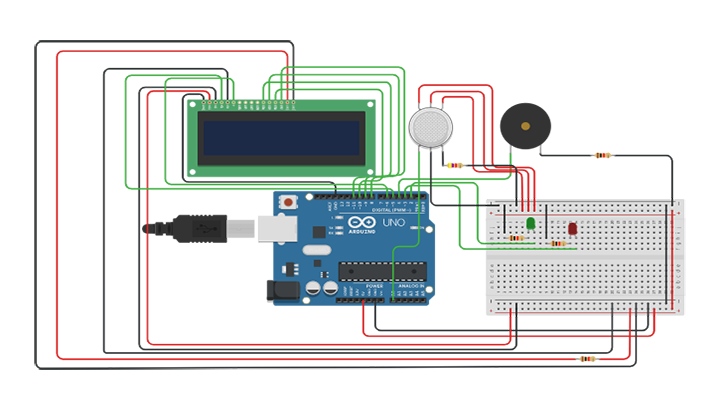Security and Surveillance System

Complementing the video surveillance component, the Security and Surveillance System incorporates motion sensors strategically deployed throughout the facility to detect any unauthorized entry or suspicious activity promptly. These sensors serve as the frontline defense, triggering immediate alerts to security personnel, thereby enabling swift and decisive responses to security incidents. Furthermore, the system integrates state-of-the-art access control mechanisms, such as electronic keycards or biometric scanners, to regulate access to restricted areas within the facility. By leveraging IoT-enabled access control systems, the Security and Surveillance System ensures that only authorized personnel can access sensitive infrastructure components, mitigating the risk of insider threats and unauthorized access.
One of the defining features of the Security and Surveillance System is its remote monitoring and management capabilities, facilitated by a centralized monitoring platform. This platform empowers security personnel to access live camera feeds, receive real-time alerts, and manage security incidents from any location with internet connectivity. Such flexibility not only enhances operational efficiency but also enables rapid response to security threats, irrespective of geographical constraints. Moreover, the system incorporates tamper detection mechanisms, utilizing IoT sensors to detect and alert security personnel of any attempts to tamper with surveillance equipment or critical infrastructure components. This proactive approach to security minimizes the risk of sabotage and ensures the integrity of the surveillance system.
Finally, the Security and Surveillance System is designed to seamlessly integrate with local law enforcement or emergency response agencies, facilitating coordinated responses to security incidents or emergencies. By establishing robust communication channels between the security system and external stakeholders, the system enhances overall safety and security measures, safeguarding telecommunications facilities against a wide range of potential threats. In summary, the Security and Surveillance System represents a paradigm shift in the protection of critical infrastructure, leveraging IoT technologies to deliver proactive, real-time security solutions tailored specifically for the telecommunications industry.
Key Components and Features:
- Video Surveillance: Install high-definition video cameras equipped with IoT connectivity to provide real-time video monitoring of key areas within and around telecommunications facilities.
- Motion Detection: Integrate motion sensors with the surveillance system to detect and alert security personnel of any suspicious activity or unauthorized entry.
- Access Control: Implement IoT-enabled access control systems, such as electronic keycards or biometric scanners, to regulate access to restricted areas and track employee movements.
- Remote Monitoring and Alerting: Develop a centralized monitoring platform that enables security personnel to remotely access live camera feeds, receive real-time alerts for security breaches, and take appropriate action as needed.
- Tamper Detection: Utilize IoT sensors to detect tampering or sabotage attempts on surveillance equipment or other critical infrastructure components, triggering immediate alerts and responses.
- Integration with Emergency Services: Integrate the security and surveillance system with local law enforcement or emergency response agencies to facilitate rapid response to security incidents or emergencies.
Problem Statement: Telecommunications facilities, including data centers, equipment sites, and network infrastructure, are critical assets that require robust security measures to protect against unauthorized access, vandalism, and security threats. Traditional security systems often lack the real-time monitoring, remote accessibility, and automated alerting capabilities necessary to effectively safeguard these facilities. As a result, there is a pressing need for an advanced security and surveillance solution tailored specifically for the telecommunications industry.
Related project idea for free
Smart school bus monitoring and notification system using RFID, GPS and ESP8266 NodeMCU
While employing technology in the classroom and school administration is the idea behind smart education, there are other aspects of education that also need to be automated. One such aspect is comforting parents while sending their children to school. One major issue in the City of Kigali is the la...
Read more>>Smart car Parking System in Kigali - Rwanda
This dissertation examines an IoT-based smart car parking system used in Rwanda. Rwanda is a nation that has to be intelligent in a variety of areas, including agriculture, health, and transportation, particularly in terms of parking. People are affected by a variety of parking issues, including tim...
Read more>>Accident Detection Based On IoT
Road accidents frequently result in damage, injuries, or fatalities and happen unexpectedly and without warning. Through the elimination of the time lag between the accident's incidence and the initial medical emergency, this research aims to lower the fatality rates following an accident. A mac...
Read more>>IoT based toxic gas detection and level of landfill - Case study: NDUBA LANDFILL
As the world's population expands, so does the amount of waste. Most landfills release harmful pollutants into the air and into the homes of those who live nearby. Effective landfill management is necessary to protect both the environment and human health and wellbeing. The findings of the litera...
Read more>>IoT based remote monitoring of water quality in tanks - Case of WASAC
Water is regarded as a basic requirement for humans in their daily lives. It is required in a variety of settings, including the home, the workplace, the manufacturing sector, the hospital, and others. The quality of the water needs to be closely monitored on a regular basis and effectively if one i...
Read more>>
